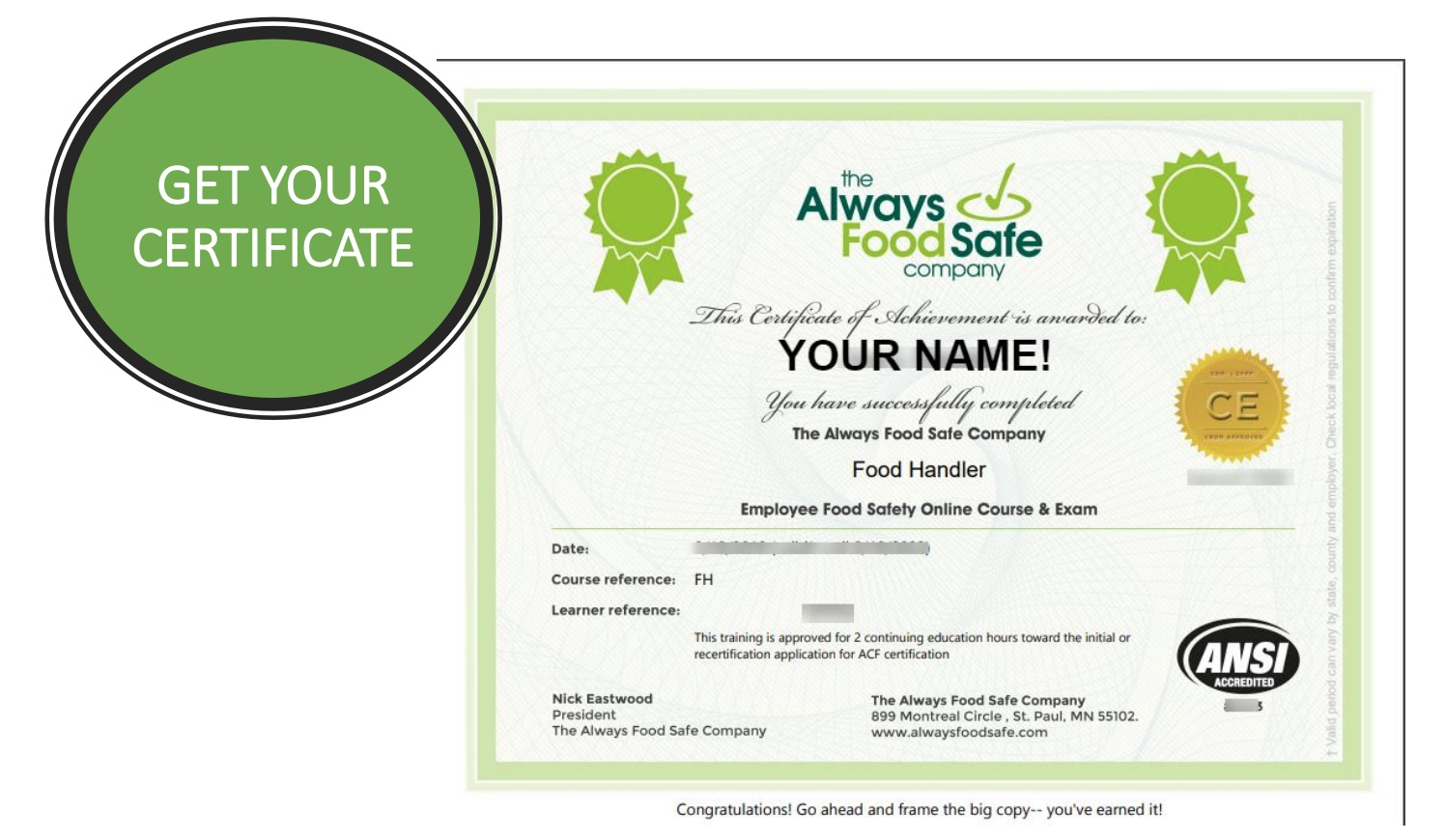ServSafe Food Handler Certification: Fast Realities for Hopeful Food Handlers
ServSafe Food Handler Certification: Fast Realities for Hopeful Food Handlers
Blog Article
Exactly How to Obtain Your Food Trainer Accreditation Quickly and Easily
Getting your food trainer qualification can seem overwhelming, yet with a critical technique, it can be achieved efficiently. Classes For Food Handlers. What are the most efficient techniques to make sure not just an effective qualification yet additionally ongoing conformity in the ever-evolving landscape of food safety?
Understand Certification Requirements
Acquiring a food handler qualification calls for a clear understanding of the certain demands stated by regional health and wellness authorities and regulative agencies. Each jurisdiction may impose different requirements and assumptions, so it is important to research the guidelines applicable to your location. Commonly, these needs consist of finishing an approved training program, passing an accreditation test, and sometimes renewing the certification regularly.
First, acquaint on your own with the local laws governing food security and handling. This might entail going to the website of your neighborhood health and wellness division or calling them directly for assistance. In addition, some areas may have particular age requirements or educational requirements, such as a minimum level of schooling.
Once you recognize the requirements, ensure that the training program you select is acknowledged by your neighborhood health and wellness authorities. This acknowledgment guarantees that the curriculum satisfies the necessary standards for reliable training in food safety practices.
Select the Right Training Course
Exactly how can you make certain that you select one of the most ideal food trainer accreditation program for your requirements? Begin by assessing the course's certification. Verify that it is recognized by your local wellness division or regulative body, as this makes sure the certification will stand for employment in your area.
Next, take into consideration the format of the course. Some people may choose in-person training for its interactive components, while others may select online courses for convenience and adaptability. Testimonial the program web content to ensure it covers crucial topics such as food security principles, personal health, cross-contamination, and appropriate food storage.
Check the duration of the training course and ensure it lines up with your routine. By thoroughly examining these factors, you can choose a food trainer certification training course that satisfies your specific needs and prepares you appropriately for your role in the food service market.
Full the Training
Upon picking the ideal food handler qualification training course, the next critical action is to complete the training. This training is designed to equip you with essential expertise pertaining to secure food taking care of practices, health, and hygiene methods. A lot of programs provide a combination of on the internet components, video clips, and interactive tests, allowing for a versatile discovering experience that can be tailored to your routine.
Some courses might also offer situation researches or real-life scenarios to enhance your understanding. This sensible application of understanding is essential, as it prepares you for the obstacles you might encounter in a food solution environment.
In addition, make sure that you allot adequate time to complete each module extensively before moving on to the following. Hurrying through the product can cause spaces in understanding, which may hinder your efficiency in future evaluations. Finishing the training with diligence will not only facilitate a smoother change to the following action in obtaining your qualification however additionally guarantee that you are well-prepared to promote food security requirements in your expert duty.
Pass the Accreditation Exam
After successfully finishing your food handler training, the following essential action is to pass the certification exam. This assessment is developed to analyze your understanding of food safety and security principles, practices, and policies that are important in the food solution market.
To prepare successfully, assess the products provided throughout your training extensively. Concentrate on key topics such as proper food storage, sanitation practices, cross-contamination avoidance, and individual hygiene criteria. Several training programs use method examinations, which can substantially boost your readiness for the actual examination.


When taking the qualification examination, guarantee you comprehend the style-- whether it contains multiple-choice concerns, true/false declarations, or practical circumstances. ServSafe Food Handler Card. Check out each question carefully and manage your time wisely, enabling cautious factor to consider of each solution
If you experience challenging questions, don't hesitate to remove clearly inaccurate alternatives to boost your possibilities of selecting the appropriate solution. After completing the exam, examine your solutions if time authorizations.

Maintain Your Qualification
Maintaining your food trainer qualification is vital for making sure ongoing compliance with market requirements and policies. Certification normally comes with particular needs, including revival timelines and continuing education and learning. It is essential to stay educated regarding these commitments to avoid gaps in your credentials.
Most jurisdictions require food handlers to renew their qualification every 3 to five years. This browse this site process commonly involves completing a refresher program or re-taking the qualification test. Routinely examining your certification's expiration date can assist you stay clear of any kind of potential disturbances in your capability to operate in food service.
Furthermore, staying updated on ideal practices and modifications this post in food safety regulations is crucial. Taking part in workshops, attending industry seminars, or subscribing to relevant newsletters can improve your expertise and keep you educated about the current fads and compliance requirements.
Last but not least, keeping a clean record in food dealing with practices is just as important. Record any type of cases, training sessions, and best methods you carry out at your office, as this can function as a valuable resource throughout renewal or assessments. By actively participating in these methods, you ensure not just the honesty of your certification however additionally the safety and contentment of your consumers.
Conclusion
Obtaining food handler certification requires an organized method that consists of understanding local demands, choosing an appropriate training course, finishing training, and passing the accreditation examination. Staying notified regarding revival demands is vital for preserving conformity with food security guidelines. By complying with these steps carefully, people can ensure they are furnished with the necessary understanding and abilities to support food safety and security criteria in their corresponding environments. Adherence to these standards eventually adds to public health and security.
How can you guarantee that you select the most ideal food handler certification training course for your needs? Evaluation the course material to guarantee it covers necessary topics go to my blog such as food safety principles, personal hygiene, cross-contamination, and proper food storage.
By thoroughly examining these elements, you can pick a food trainer accreditation course that satisfies your certain needs and prepares you adequately for your duty in the food solution sector.
Upon picking the appropriate food handler accreditation program, the next essential step is to finish the training.Getting food trainer qualification entails a methodical method that includes understanding local needs, selecting an appropriate training course, finishing training, and passing the accreditation exam.
Report this page